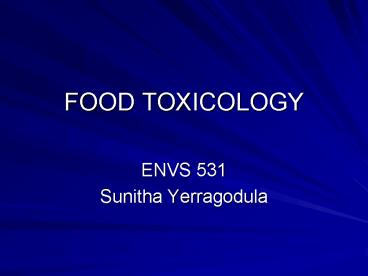FOOD TOXICOLOGY - PowerPoint PPT Presentation
1 / 19
Title:
FOOD TOXICOLOGY
Description:
There is no explicit definition for the term safety, of substances added to food. ... Scientific experts determine whether a substance that is to be added to a ... – PowerPoint PPT presentation
Number of Views:8210
Avg rating:3.0/5.0
Title: FOOD TOXICOLOGY
1
FOOD TOXICOLOGY
- ENVS 531
- Sunitha Yerragodula
2
Uniqueness of food toxicology
- Nature of food makes it unique
- Food is subjected to unpredictable forces of
nature and hence unreliable. - Assessment of safety of substances added to food,
natural substances in food,
- Safe is a term which is most used in food
toxicology - An understnading of this term is necessary in
deciding how many and what types of studies must
be conducted to determine that an added substance
is safe.
3
Contd
- There is no explicit definition for the term
safety, of substances added to food. - The one principle on which there is unanimous
agreement is that safety concerns should focus on
both the nature of the substance and its
intended conditions of use.
4
GI Tract
- Toxicological studies mostly focus on the
digestion and metabolism occurring in the GI
tract. - The reason for this focus is that in most cases
it is not the ingested substance that is absorbed
through the GI tract it is products of its
digestion that are absorbed. - And hence GI tract is important.
5
GRAS
- Generally regarded as safe
- Scientific experts determine whether a substance
that is to be added to a food is GRAS.
- In addition to GRAS the FDC Act provides a class
of substances that are regulated as food
additives, which are not generally recognized to
be safe. - Hence there is a legal distinction between GRAS
and Food additives
6
Tolerance
- A food may be declared unfit if it contains
unavoidable contaminant that may render the food
injurious. - But, an unavoidable contaminant in food, need
only pose a risk to be found unfit and subject to
FDA action. - At times, foods containing unavoidable
contaminants cannot be banned.
7
Contd..
- Under provisions of Sec 406 of the FDC Act, the
quantity of the unavoidable contaminant in food
may be limited by regulation. - Ex Action levels for Aflatoxin in peanuts,
grain, and milk.
8
Food and Color additives
- Any intentionally added ingredient, not
considered GRAS is either a food additive or
color additive. - A color additive has generally only one function,
while food additives have 32 functionalities.
9
Food and Color additives
10
Contd..
- Color additives consist of aromatic amines or
aromatic azo structures. - FDC Act permits such colors still.
- The reason being the sulfonation of these
compounds. - Beverages, Candy and Confections, Bakery goods,
Sausages etc.. Are some of the foods that utilize
food additives.
11
Safety evaluation of direct food and color
additives
- Estimated daily intake
- EDI CI
- C is the concentration of the substance added in
that food - I is the daily intake of the food in which the
substance will be used.
12
Transgenic Plant
13
Carcinogenicity
- The Delaney clause, prohibits the approval of
regulated food additives found to induce cancer
when ingested by man or animals . - One of the draw backs is that it applies to only
food additives, color additives, and animal drugs
but not to unavaoidable contaminants or GRAS
substances sanctioned by the FDA before 1958.
14
Adverse Reactions to food or food ingredients
- FOOD Allergy Immune mediated reaction
- FOOD Idiosyncracy Quantitatively abnormal
response- not an immune mediated reaction, buta
genetically predisposed reaction. - Anaphylactoid reactions
- Pharmacologic food reactions.
- Metabolic food reactions.
15
Foods for which tolerances can be set
- Pesticide residues in food
- Heavy metals like Pb, As, Cd.
- Chlorinated organics.
16
Substances for which tolerance can not be set
- Toxins in Fish, Shell fish, turtles
- Microbiologic agents, like Clostridium
botlulinum, Clostridium butyricus, E.coli. - Bovine spongiform Encephalopathy
- Substances produced by cooking.
17
Why ??????
- Because they are regarded as avoidable or of such
hazard that a safe level cannot be set, therefore
the FDA has determined that food containing such
substances is banned or - Beyond the control of the FDA and cannot be
regulated
18
Reference
- Chapter 30, Food Toxicology, Casarett Doulls
Toxicology, Curtis D.Klaassen, 2001 edition.
19
Questions
- Aromatic amines are added in Color additives,
despite their known toxicity. Why? - Why does the population in Southeast Asia more
prone to symptoms like malabsorption and diarrhea?

